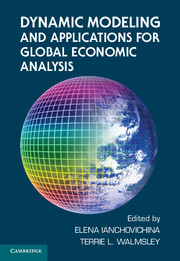Book contents
- Frontmatter
- Contents
- Contributors
- Acknowledgments
- PART I INTRODUCTION AND OVERVIEW
- PART II STRUCTURE OF THE DYNAMIC GTAP FRAMEWORK
- PART III APPLICATIONS OF DYNAMIC GTAP
- 8 Assessing the Impact of China's WTO Accession on Investment
- 9 Dynamic Effects of the “New-Age” Free Trade Agreement between Japan and Singapore
- 10 Resource Use and Technological Progress in Agriculture
- 11 Global Economic Integration and Land-Use Change
- 12 The Contribution of Productivity Linkages to the General Equilibrium Analysis of Free Trade Agreements
- 13 Global Demographic Change, Labor Force Growth, and Economic Performance
- PART IV EVALUATION OF THE DYNAMIC GTAP FRAMEWORK
- Appendix: Negative Investment: Incorporating a Complementarity into the Dynamic GTAP Model
- Glossary of GDyn Notation
- Index
- References
8 - Assessing the Impact of China's WTO Accession on Investment
Published online by Cambridge University Press: 05 June 2012
- Frontmatter
- Contents
- Contributors
- Acknowledgments
- PART I INTRODUCTION AND OVERVIEW
- PART II STRUCTURE OF THE DYNAMIC GTAP FRAMEWORK
- PART III APPLICATIONS OF DYNAMIC GTAP
- 8 Assessing the Impact of China's WTO Accession on Investment
- 9 Dynamic Effects of the “New-Age” Free Trade Agreement between Japan and Singapore
- 10 Resource Use and Technological Progress in Agriculture
- 11 Global Economic Integration and Land-Use Change
- 12 The Contribution of Productivity Linkages to the General Equilibrium Analysis of Free Trade Agreements
- 13 Global Demographic Change, Labor Force Growth, and Economic Performance
- PART IV EVALUATION OF THE DYNAMIC GTAP FRAMEWORK
- Appendix: Negative Investment: Incorporating a Complementarity into the Dynamic GTAP Model
- Glossary of GDyn Notation
- Index
- References
Summary
Introduction
During the 1980s and 1990s, China carried out significant reforms to restructure and open up its economy to foreign trade. These reforms helped spur a period of rapid growth, with annual growth in real per capita GDP averaging 6.04% over the period 1978–95 (Maddison 1998). However, reforms to the legislative framework governing foreign investment in China have proceeded more slowly. Entry into certain sectors, as well as the share of foreign ownership, is significantly limited, and joint ventures typically remain the best option for foreign investors. In an effort to boost foreign investment, the Chinese government began offering a number of special incentives in the early 1990s, including duty drawbacks on imported intermediate inputs and capital goods used for the production of exports, exemptions and reductions in the rate of income taxes paid on profits,1 and preferential tax rates for foreign enterprises that reinvest their profits (China Council 2000). These incentives paid off, with foreign investment increasing sharply in 1992–3 (Fig. 8.1). Indeed, by 1994 China accounted for approximately 20% of all foreign direct investment (FDI) in developing countries (Garbaccio 1995).
However, by 1996 the rate of growth in FDI had begun to slow (Fig. 8.1). A survey of the Chinese economy by The Economist (2000) explored some of the reasons behind the FDI slowdown in China. In many cases investors' high hopes for this market were slow to materialize, with the absence of a rules-based economy making it difficult for outsiders to operate effectively in China.
- Type
- Chapter
- Information
- Dynamic Modeling and Applications for Global Economic Analysis , pp. 205 - 234Publisher: Cambridge University PressPrint publication year: 2012
References
- 1
- Cited by



